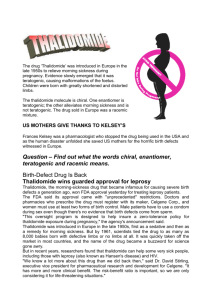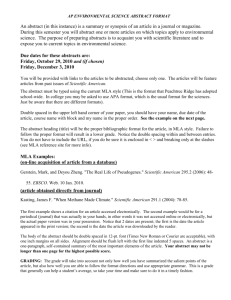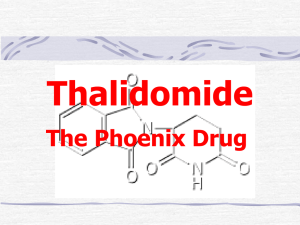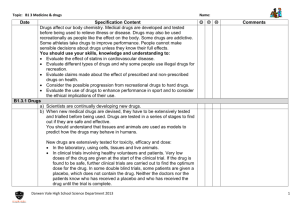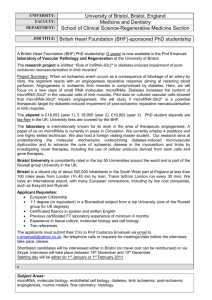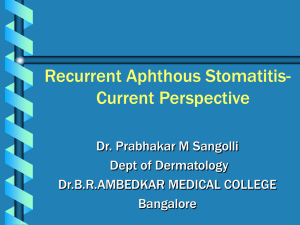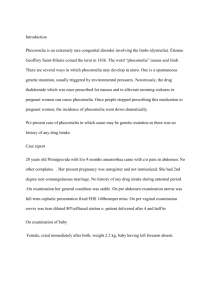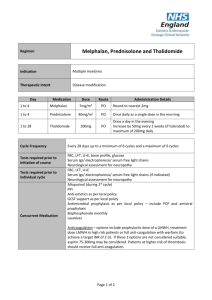BIOL 501 Article Summary 1
advertisement
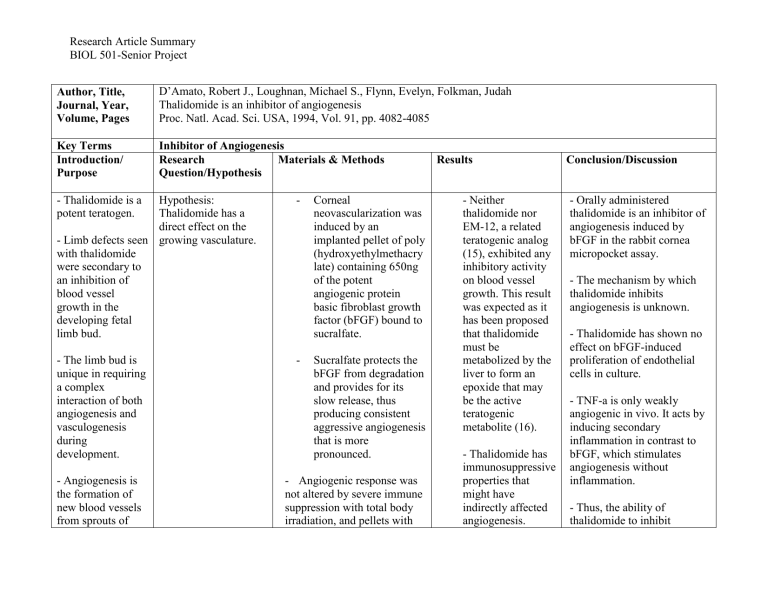
Research Article Summary BIOL 501-Senior Project Author, Title, Journal, Year, Volume, Pages D’Amato, Robert J., Loughnan, Michael S., Flynn, Evelyn, Folkman, Judah Thalidomide is an inhibitor of angiogenesis Proc. Natl. Acad. Sci. USA, 1994, Vol. 91, pp. 4082-4085 Key Terms Introduction/ Purpose Inhibitor of Angiogenesis Research Materials & Methods Question/Hypothesis - Thalidomide is a potent teratogen. Hypothesis: Thalidomide has a direct effect on the - Limb defects seen growing vasculature. with thalidomide were secondary to an inhibition of blood vessel growth in the developing fetal limb bud. - - The limb bud is unique in requiring a complex interaction of both angiogenesis and vasculogenesis during development. - - Angiogenesis is the formation of new blood vessels from sprouts of Corneal neovascularization was induced by an implanted pellet of poly (hydroxyethylmethacry late) containing 650ng of the potent angiogenic protein basic fibroblast growth factor (bFGF) bound to sucralfate. Sucralfate protects the bFGF from degradation and provides for its slow release, thus producing consistent aggressive angiogenesis that is more pronounced. - Angiogenic response was not altered by severe immune suppression with total body irradiation, and pellets with Results - Neither thalidomide nor EM-12, a related teratogenic analog (15), exhibited any inhibitory activity on blood vessel growth. This result was expected as it has been proposed that thalidomide must be metabolized by the liver to form an epoxide that may be the active teratogenic metabolite (16). - Thalidomide has immunosuppressive properties that might have indirectly affected angiogenesis. Conclusion/Discussion - Orally administered thalidomide is an inhibitor of angiogenesis induced by bFGF in the rabbit cornea micropocket assay. - The mechanism by which thalidomide inhibits angiogenesis is unknown. - Thalidomide has shown no effect on bFGF-induced proliferation of endothelial cells in culture. - TNF-a is only weakly angiogenic in vivo. It acts by inducing secondary inflammation in contrast to bFGF, which stimulates angiogenesis without inflammation. - Thus, the ability of thalidomide to inhibit Research Article Summary BIOL 501-Senior Project preexisting vessels. - Vasculogenesis is the formation of a capillary bed from endothelial cells that have differentiated from mesenchymal precursors.” sucralfate alone did not induce angiogenesis (data not shown). The new vessels are primarily induced by the bFGF. Recently, angiogenesis induced by thalidomide has pharmacologic doses of bFGF been used for its supports the hypothesis that immunosuppressive thalidomide directly inhibits properties in the an essential component of treatment of angiogenesis and does not leproma reactions operate through effects on (19) and chronic TNF-a production. graft versus host disease (18, 20-23). - In conclusion, thalidomide is a potent angiogenesis inhibitor The teratogenic in vivo. analog EM-12, which shares the - Evaluation of thalidomide other properties of analogs demonstrated a thalidomide, was correlation between also inhibitory, teratogenicity and with a median antiangiogenic potential. inhibition of 42%. - There are clear implications - Supidimide, a for the use of this drug in the non-teratogenic treatment of pathologic analog that retains angiogenesis that occurs in the sedative diabetic retinopathy, macular properties of degeneration, and solid thalidomide, tumors. exhibited no activity. - Other analogs, PGA and PG acid, displayed weaker inhibitory effects Research Article Summary BIOL 501-Senior Project than thalidomide. - The corneal neovascularization from thalidomide-treated rabbits appeared more immature than that observed in control animals with poorly formed cell junctions, incomplete basement membrane, and fewer associated pericytes. Unknown Vocabulary: corneal neovascularization, chorioallantoic, sucralfate, limbus, *Supidimide, leukocytopenia, superior rectus, epoxide, *EM-12, phthaloylglutamic anhydride (PGA), phthaloylglutamic acid (PG acid), avascular zones, carboxymethylcellulose, fenestrations, cellular hypoxic, Thalidomide induces limb defects by inhibiting angiogenesis during the critical point of limb and organ development in gestation (Robert J. D'Amato, 1994). It is proposed that thalidomide induces limb defects by inhibiting blood vessel growth in the developing fetal limb bud (Robert J. D'Amato, 1994). The limb bud is unique in requiring a complex interaction of both angiogenesis and vasculogenesis during development. Angiogenesis is the formation of new blood vessels from sprouts of preexisting vessels. Vasculogenesis is the formation of a capillary bed from endothelial cells that have differentiated from mesenchymal precursors (Robert J. D'Amato, 1994). Thalidomide can be beneficial for anti-cancer medications due to its anti-angiogenetic effects. Drugs with anti-angiogenetic effects can be used as anti-cancer medications (Robert J. D'Amato, 1994).
